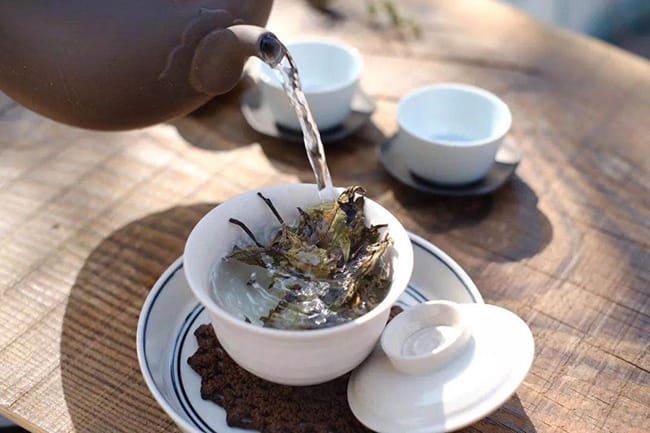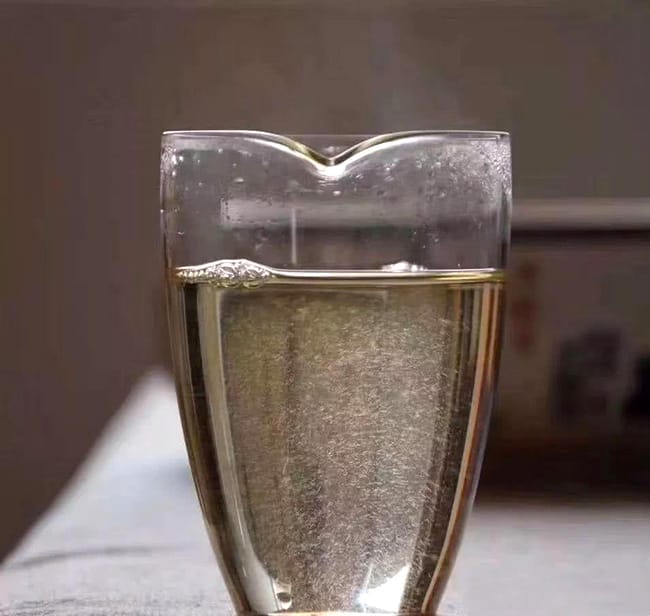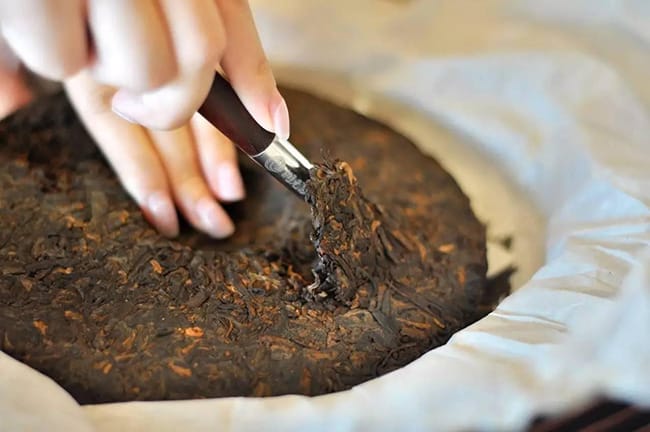Last Updated on 06/28/2021 by Desmond
I often suggest pouring away the first brewed when making tea in some of my guides; Wash Tea, Rinse Tea, Pre brew, whatever you call it. You might think, what a waste it is! Why should you rinse the tea leaves, and how to do it properly? Now follow me and keep reading, and left a comment telling me your idea.
CONTENT
Why People Rinse The Tea Leaves Before Brewing?
What is rinsing tea for? Even you ask some Chinese friends, they may not give a positive answer, and just tell you that’s for the cleaning. Of course, that makes some sense, and it’s also the original purpose. But in fact, there is more behind rinsing tea.
Cleaning
Near 90% of Chinese will rinse the leaves before brewing. Most of them thought, except for some teas like Dongfang Meiren, which is cultivating uniquely, the others all will use the pesticide inevitably. And the pesticide may residual on the leaves and harmful to the health. Actually, you really do not need to worry about this problem.
First, nowadays, almost all the tea-producing countries have a strict standard to manage tea products. If the residue pesticide amount over the standard, the tea will not be allowed to sell on the market. So even few pesticides residual on the leaves, they have less effect on the health, just like the vegetables we eat daily.
A reason that makes you more feel relieved. Most high-quality loose leaf tea, especially green tea and yellow tea, are all made from the tenderest buds harvested in spring. Bugs haven’t yet begun to breed at that time, and farmers had no reason to use pesticides. In other words, high-quality teas have no pesticide retained, and only the leaves harvested in summer and autumn may get some with. Besides, suppose you are unfortunately bought the tea with pesticide residues, several seconds of rinsing is not able to clean them up.
Compared with the pesticide problem, people rinsing tea more is for dust removal. Some loose-leaf tea without a sealed individual package is easy to get some dust on during storage. Like dark tea and white peony tea, which are need to aging, the dust problem will be more serious. For these teas, many tea brewing guides are also recommended for rinsing twice.
Besides, most dark tea, white tea, and Pu-erh green tea are in a tea-cake style, and you have to pry the leaves you need with a knife before brewing. Unless you are very good at this, or the leaves will be broke a little inevitably. The splinters are hard to filter out ever with an infuser, affecting the mouthfeel a lot. So to pour away the first brew of these teas is unblamable.
Preheat And Wake The Leaves Up
Some tea lovers may know that rinsing the leaves can not only clean the dust and splinters up, and it helps to preheat the leaves, waking them and make them better at releasing the flavor.
Most loose-leaf teas had been through rolling, and their leaves are tight and curly. Some Oolong teas like Tieguanyin, leaves will be rolled into small balls; and the compressed tea-cakes are much tighter. Once the dried leaves meet the hot water, they will absorb and unfold their bodies. A larger surface area means it can be heating better, the nutrients and flavor substances contained in tea, like tea polyphenols, amino acid, and caffeine, can release faster.
Then you may have a question. In this case, doesn’t it means some nutrients and flavors will lost? Indeed, even though the rinsing just lasts several seconds, it still leads to some waste. Still, the influences can be said it’s negligible. Some people may think they can get the decaffeinate effect through rinsing the leaves before brewing, and it also affects less.
Traditional Etiquette
As a Cantonese, in my opinion, most of the time, rinse tea is a habit based on traditional etiquette. It is said that people started rinse tea in Ming Dynasty, the government abolished producing block tea and promoted loose-leaf tea. At that time, the production environment and transportation were less developed. Even the tea for the noble served was full of dust; to rinse the leaves before brewing was necessary.
One more thing, the wash tea habit may have a little relationship with the traditional Chinese filial piety culture.
Everyone knows that the Chinese are very respectful and believe in their elders. Even though in the material scarcity ancient time, once people got some nice food, they will worship it to their ancestors first before feeding themselves. For wine, they will pour the first cup on the ground as sacrificing. And for tea, the first brew was regarded as the best; it must let the ancestors take the first taste.
Chaoshan region is the origin of the Gongfu tea ceremony, and the worship ancestors’ culture is the deepest there. Taking rinsing tea as one important step in the Gongfu tea ceremony may be respected for the traditional culture.
Combine all the above reasons, even though the teas now cannot be too dirty to must be washed, rinsing the tea before brewing has become a tea-drinking habit. And this habit is also get popularized along with the tea culture promotion. So many people do not know why but still will do this.
Should I Rinse The Leaves? How?
Actually, unless you take part in a match, whether to rinse the tea before brewing depends on you. You can wash the leaves once or twice until you think it is OK to drink. Or you can direct drink the first brew, making no waste. Be rest assured, as long as the tea is safe, and either decision would not cause any harm to your health.
Suppose you prefer to rinse the tea, that there are some things you still need to pay attention to. Besides, it’s really not all the teas need to wash.
Rough Tea
In the Chinese tea industry, tea masters own their plantations. They harvest the leaves and primary-process them into rough tea, then sold to the factories for further processing or for tea lovers drinking. Typically, these leaves don’t have a good package. The safety is without a guarantee because they are all processed in individual small workshops. So suppose you got some rough tea from friends, and that will be better rinsing it for 3-5 seconds before brewing.
Green Tea, Yellow Tea, and White Tea
Most green tea, yellow tea, and white tea are made from the tenderest buds and leaves harvested in spring. Theoretically, it’s no need to worry about the pesticide residue problem. For these teas, it is not suggested to rinse. Because the leaves are tender, they contain relatively fewer components than the older ones, and they are also not resistant to brew. So to wash them before brewing may make to a large loss.
Worth knowing that sometimes you may see much tiny white fuzz on the leaves’ surface and look moldy. When brewing, they make the infusion seems muddy. Don’t worry, these white fuzzes are called “Hao” They symbolize high-quality tea, rich in amino acid, and bring a brisk mouthfeel. They are treasures, and you should never pour away the first brew which is full of them.
Black Tea
There are two common black tea styles: CTC and Loose-leaf. CTC black tea is popular in South Asia and the West; most of the time, they are used to make milk tea. Its flavor releases very fast, and if you rinse before brewing, it will be tasteless in the next brew. And for the loose-leaf black tea, like Yinghong No.9, its flavor releases slower. Having a rinse before brewing can help wake the leaves up, making them better release flavor.
Dark Tea
Almost all the dark teas are in a compressed tea style, and you need a knife to help take the leaves before brewing. Just like we said before, it would bring many splinters and affect the mouthfeel. And dark tea has been long-time aging, with much dust on the surface inevitably. If you are not rinsing them before brewing, the first brew will tastes strange, stuffy like the earth. Thus, many people will wash the leaves at least twice before making dark tea.
Suppose you are going to make Tibetan butter tea or Mongolian milk tea. After you put the leaves in the pot, and if you see any dust floating on the water, just remove them with a spoon.
Worth knowing, some dark teas, especially the Fuzhuan tea, have many “golden flowers” breeding inside. They are not bad things but beneficial fungus and great for health. No need to wash them away when brewing.
Oolong Tea
Oolong tea is the most favorite of Chaoshan people. Most Oolong teas have been through baking and got a roasted flavor. But due to this, a little charcoal ash is residual on the leaves. So when making Oolong tea, people typically do once leaves-rinsing first, for cleaning and preheating. Besides, the roasted leaves are regarded to have much “heat” in traditional Chinese medicine, which will easily lead to inflammation; a rinsing also helps reduce this “heat.”




